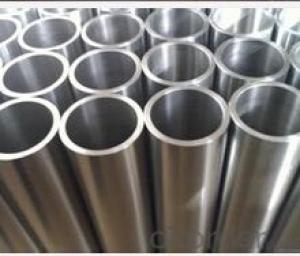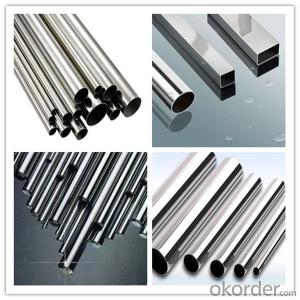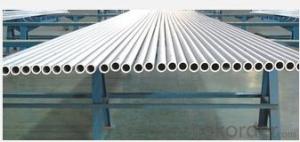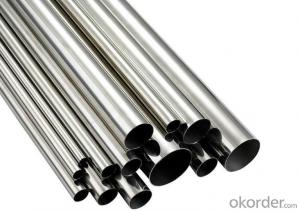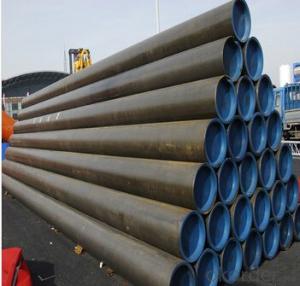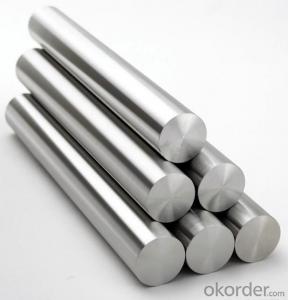STAINLESS STEEL INDUSTRIAL PIPE
- Loading Port:
- China Main Port
- Payment Terms:
- TT OR LC
- Min Order Qty:
- -
- Supply Capability:
- -
OKorder Service Pledge
Quality Product, Order Online Tracking, Timely Delivery
OKorder Financial Service
Credit Rating, Credit Services, Credit Purchasing
You Might Also Like
Specifications
1. Guaranteed material from established steel factories2. Accordance with International standard
3. Attractive 304 price
PRODUCT NAME: STAINLESS STEEL INDUSTRIAL PIPE
| Name | Stainless Steel Industrial Pipe |
| Standard | ASTM, GB, JIS, DIN, EN, AISI |
| Material Grade | TP304 TP304L TP316 TP316L TP347 TP347H TP321 TP321H TP310 TP310S |
| TP410 TP410S TP403 | |
| S31803/S32205 S32750 S32760 | |
| Outer Diameter | Welded Pipe: single slit(Φ8mm-Φ630mm); girth(Φ630mm-Φ3000mm), |
| Thickness | Welded Pipe: single slit(0.5mm-25mm); girth(3mm-30mm) |
| Length | Commonly 5.8 Meters or 6.0 Meters, or as customers' request |
| Tolerance | According to the Standard, +/-10% Commonly. |
| Surface | 180#, 320#, 400# Satin / Hairline, Bright Anneal, Pickle,400#, 500#, 600# or 800# Mirror finish |
| Application | Petrochemical industry, chemical fertilizer industry, oil refining industry, oil and gas industry, light industry and food industry, pulp and paper industry, energy and environmental industries. |
| Test | Flaring test, Flattening test, Bending Test, Hydraulic Test, Eddy Current test |
- Q: Can stainless steel pipes be insulated with polycaprolactone?
- Stainless steel pipes can indeed be insulated with polycaprolactone. Polycaprolactone, also known as PCL, is a thermoplastic polymer that has excellent thermal insulation properties. It has a low thermal conductivity, which makes it an effective choice for insulating pipes and preventing heat loss or gain. Additionally, PCL is also resistant to moisture and chemicals, making it suitable for various environments and applications. When applied as insulation on stainless steel pipes, polycaprolactone can help maintain the desired temperature, reduce energy consumption, and prevent condensation.
- Q: How do you measure the thickness of a stainless steel pipe?
- There are various techniques available for measuring the thickness of a stainless steel pipe, depending on the tools at hand and the desired level of accuracy. One commonly used approach involves utilizing a caliper or micrometer, which are precision measuring instruments. By opening the caliper and positioning one jaw on the outside surface of the pipe and the other jaw on the inside surface, one can determine the distance between the jaws. This measurement provides the thickness of the pipe. Another option involves utilizing an ultrasonic thickness gauge. This device emits high-frequency sound waves that penetrate the pipe and bounce back from the inner wall. By measuring the time it takes for the sound waves to travel and return, the gauge can calculate the pipe's thickness. For larger pipes or situations requiring greater precision, a laser-based method can be employed. Laser-based devices use a laser beam to scan the pipe's surface and measure the distance from the beam to the surface. By scanning along the pipe's circumference, multiple measurements can be obtained and averaged to establish the thickness. It is important to note that prior to measuring the thickness, it is crucial to ensure that the pipe's surface is clean and devoid of any debris or coatings that might impact the accuracy of the measurements. Additionally, it is advisable to take multiple measurements at different points along the pipe's length to account for any variations in thickness.
- Q: Are stainless steel pipes suitable for fire sprinkler systems?
- Indeed, fire sprinkler systems find stainless steel pipes to be a suitable choice. The durability and longevity of stainless steel, owing to its remarkable resistance to corrosion, make it an ideal material for pipe systems. This corrosion resistance ensures that the pipes will not weaken or deteriorate over time, thus guaranteeing the fire sprinkler system's dependability and effectiveness. Furthermore, stainless steel pipes possess outstanding heat resistance, a crucial attribute in fire protection systems. They can endure high temperatures without warping or melting, thereby ensuring that the pipes will not fail in the event of a fire emergency. All in all, stainless steel pipes offer the requisite strength, durability, and heat resistance needed in fire sprinkler systems, rendering them a suitable choice for such applications.
- Q: What is the difference between electropolished and passivated stainless steel pipes?
- Both electropolished and passivated stainless steel pipes are utilized as surface treatments in order to enhance the corrosion resistance and aesthetic appearance of stainless steel. Nevertheless, there exist notable distinctions between the two procedures. Electropolishing serves as an electrochemical method which selectively eradicates a minute layer of material from the surface of the stainless steel. This process aids in eliminating impurities, contaminants, and embedded particles, thereby resulting in a sleek and pristine surface. Furthermore, electropolishing enhances the microfinish of the stainless steel, thereby reducing surface roughness and elevating the overall appearance. It also augments the corrosion resistance of stainless steel by fostering the formation of a passive chromium oxide layer on the surface. Conversely, passivation is a chemical process that involves the application of an acid-based solution onto the surface of the stainless steel. This solution assists in eliminating iron contaminants and other foreign substances from the surface, leaving behind a spotless and passive layer of chromium oxide. Passivation serves to enhance the corrosion resistance of stainless steel by promoting the creation of a stable and protective oxide layer. In conclusion, electropolishing represents an electrochemical approach that eradicates a thin layer of material, thereby generating a smooth and pristine surface, whereas passivation constitutes a chemical process that eliminates contaminants and encourages the development of a safeguarding oxide layer. Both procedures contribute to heightening the corrosion resistance and aesthetics of stainless steel pipes, although they differ in the methodologies employed to achieve these outcomes.
- Q: Are stainless steel pipes resistant to intergranular corrosion?
- Yes, stainless steel pipes are resistant to intergranular corrosion. Stainless steel contains a high amount of chromium, which forms a passive oxide layer on the surface of the metal. This oxide layer acts as a protective barrier, preventing the penetration of corrosive agents and inhibiting the occurrence of intergranular corrosion. Additionally, stainless steel pipes are often alloyed with elements such as molybdenum or titanium, which further enhance their resistance to intergranular corrosion. However, it is important to note that the resistance to intergranular corrosion may vary depending on the specific grade of stainless steel and the environmental conditions in which the pipes are exposed.
- Q: Can stainless steel pipes be used in the construction industry?
- Yes, stainless steel pipes can be used in the construction industry. Stainless steel offers many advantages, making it a preferred choice for various construction applications. Firstly, stainless steel pipes have excellent corrosion resistance, which is essential in construction projects that involve exposure to moisture, chemicals, or extreme weather conditions. This resistance to corrosion ensures the longevity and durability of the pipes, reducing maintenance and replacement costs. Furthermore, stainless steel pipes have high strength and impact resistance, making them suitable for structural applications in buildings, bridges, and other construction projects. Their strength allows for the transportation of fluids and gases under high pressure, making them ideal for plumbing and HVAC systems. Stainless steel pipes are also highly hygienic and resistant to bacteria growth, making them suitable for applications in the food and beverage industry, hospitals, and laboratories. They are easy to clean and maintain, ensuring the safety and purity of the transported materials. Additionally, stainless steel pipes have aesthetic appeal, as they can be polished to a high shine or finished in various colors, making them suitable for architectural purposes. They can be used for handrails, staircases, exterior cladding, and other decorative elements in buildings. Overall, stainless steel pipes are versatile, durable, and corrosion-resistant, making them an excellent choice for the construction industry.
- Q: Can stainless steel pipes be used for agricultural irrigation systems?
- Yes, stainless steel pipes can be used for agricultural irrigation systems. Stainless steel is a highly durable and corrosion-resistant material, making it suitable for various applications, including agricultural irrigation. It is known for its resistance to rust and corrosion, even when exposed to moisture, chemicals, and fertilizers commonly used in irrigation systems. Additionally, stainless steel pipes can withstand high-pressure water flow, making them ideal for delivering water to crops efficiently. Moreover, stainless steel is environmentally friendly as it is 100% recyclable, making it a sustainable choice for agricultural irrigation systems.
- Q: Can stainless steel pipes be insulated with polystyrene sulfonate?
- Yes, stainless steel pipes can be insulated with polystyrene sulfonate. Polystyrene sulfonate is a type of insulation material that is commonly used for its excellent thermal and moisture resistance properties. It can be applied to stainless steel pipes to reduce heat loss or gain and prevent condensation. This insulation material can provide effective insulation in a wide range of temperatures and is often chosen for its durability and long-lasting performance. However, it is important to ensure that the polystyrene sulfonate insulation is compatible with the specific application and meets the necessary safety and regulatory requirements.
- Q: What is the difference between 17-4PH and 15-5PH stainless steel pipes?
- The main difference between 17-4PH and 15-5PH stainless steel pipes lies in their chemical composition and mechanical properties. 17-4PH stainless steel is a precipitation-hardening grade that contains 17% chromium, 4% nickel, 4% copper, and a small amount of molybdenum. It is known for its excellent combination of high strength and corrosion resistance. This grade can be heat treated to achieve different levels of hardness, making it suitable for various applications that require both strength and corrosion resistance. On the other hand, 15-5PH stainless steel is also a precipitation-hardening grade but with a slightly different composition. It consists of 15% chromium, 5% nickel, and 3-5% copper. This grade offers good strength, toughness, and corrosion resistance, comparable to 17-4PH stainless steel. However, it has a higher level of toughness and better resistance to stress corrosion cracking. In terms of mechanical properties, 17-4PH stainless steel generally has higher strength and hardness compared to 15-5PH stainless steel. It can be heat treated to achieve a wide range of hardness levels, including high strength and hardness suitable for demanding applications. 15-5PH stainless steel, although still possessing good strength, is typically not heat treated to the same extent as 17-4PH. Both 17-4PH and 15-5PH stainless steel pipes are commonly used in industries such as aerospace, oil and gas, and chemical processing, where their combination of strength and corrosion resistance is highly beneficial. The choice between the two grades depends on specific application requirements, with 17-4PH offering higher strength and hardness versatility, while 15-5PH providing better resistance to stress corrosion cracking and improved toughness.
- Q: What is the difference between 304J5 and 316J5 stainless steel pipes?
- The main difference between 304J5 and 316J5 stainless steel pipes lies in their composition. While both are stainless steels, 304J5 contains a higher percentage of chromium and nickel, making it more corrosion resistant than 316J5. On the other hand, 316J5 contains a small amount of molybdenum, which enhances its resistance to pitting and crevice corrosion. Therefore, if corrosion resistance is of utmost importance, 304J5 would be the preferred choice, whereas if added resistance against pitting and crevice corrosion is desired, 316J5 would be the better option.
Send your message to us
STAINLESS STEEL INDUSTRIAL PIPE
- Loading Port:
- China Main Port
- Payment Terms:
- TT OR LC
- Min Order Qty:
- -
- Supply Capability:
- -
OKorder Service Pledge
Quality Product, Order Online Tracking, Timely Delivery
OKorder Financial Service
Credit Rating, Credit Services, Credit Purchasing
Similar products
Hot products
Hot Searches
Related keywords
